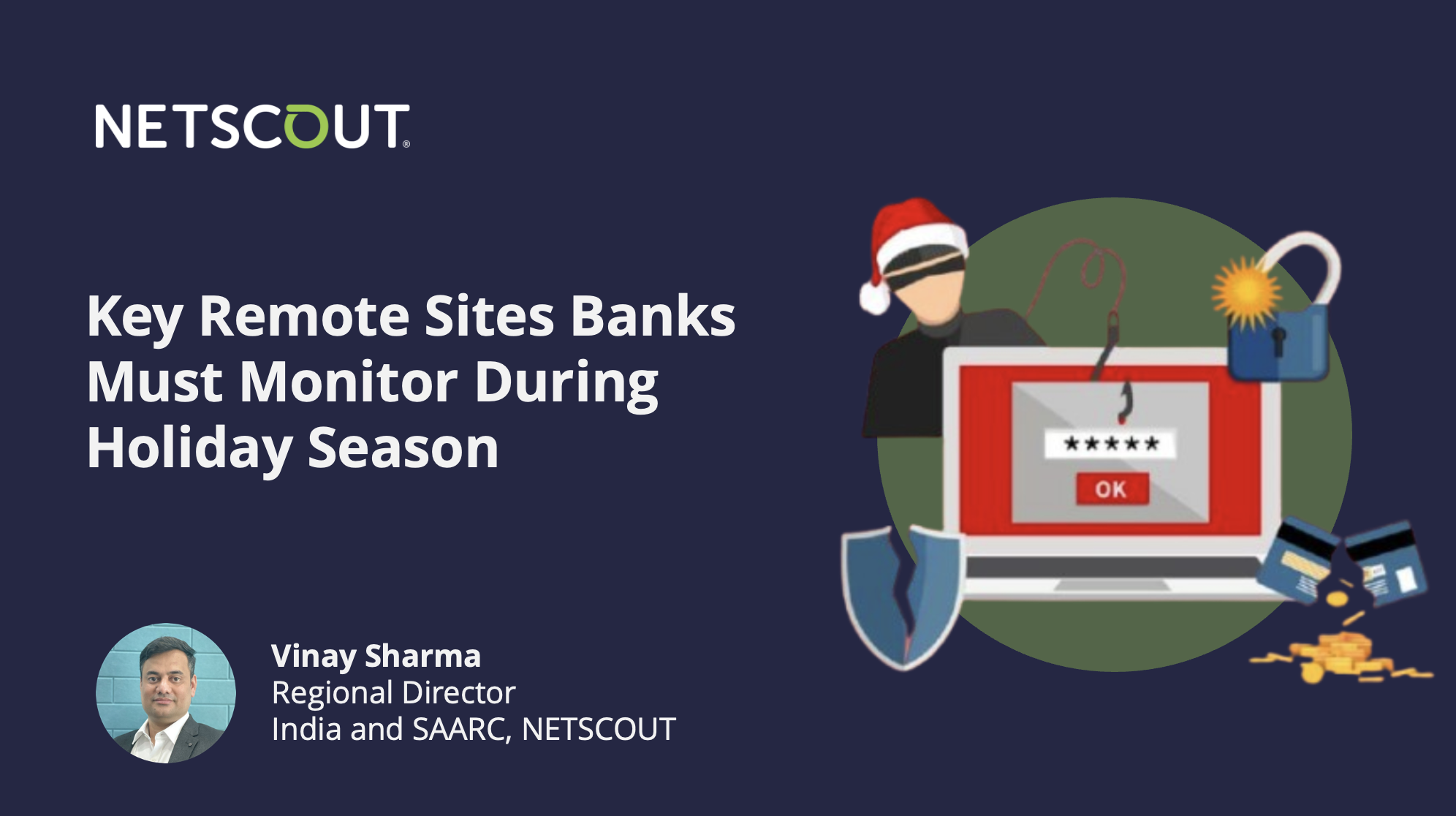Key Remote Sites Banks Must Monitor During Holiday Season - Vinay Sharma, Regional Director, India and SAARC, NETSCOUT

In
the banking industry, trust is the cornerstone of a company's reputation and
customer loyalty. Network and application performance issues can erode this
trust, prompting loyal customers to seek more reliable institutions to
safeguard their finances.
During
the holiday and festive seasons, consumer spending in India sees a significant
surge, particularly in unique gifts and travel. This spike in expenditure
highlights the growing demand for reliable banking services, including credit
and debit card authorizations, deposits, and withdrawals. Today’s customers
expect seamless, secure, and uninterrupted access to online transactions across
mobile apps, web platforms, and voice-based services.
For retail banks, ensuring compliance, robust security, and service level assurance across financial delivery platforms is more critical than ever. Customers must trust their banks to safeguard their accounts and execute transactions flawlessly. In a competitive banking landscape where reputation directly influences customer loyalty, consistent network and application performance is vital to success.
Digital
transformation and mobile banking have reshaped the financial services
industry, placing a premium on delivering exceptional digital experiences to
sustain customer satisfaction and loyalty. Customer service remains a
cornerstone, ensuring prompt resolution of issues and seamless assistance when
needed.
Given the complexity of banking infrastructures, IT teams require comprehensive end-to-end visibility across data centers, cloud environments, and distributed remote locations. This holistic observability is essential for maintaining the convenience and accessibility that customers expect from modern banks.
Key Remote Locations That Gain
from Enhanced Observability
To
troubleshoot effectively and minimize disruptions to customers and employees,
leading banks rely on end-to-end visibility across these remote locations,
1. Contact centers: To ensure high-quality digital experiences for customers, banks require real-time monitoring of voice and video technologies. Issues like lagging connections, dropped calls, or muffled audio during time-sensitive interactions with contact center agents can lead to frustration and loss of business. Deep Packet Inspection (DPI) offers critical insights into network performance, identifying issues affecting voice and video services, such as error data, Quality-of-Service (QoS) class assignments, and metrics like the Mean Opinion Score (MOS). Additionally, synthetic testing enables IT teams to evaluate service quality before customers connect with agents, ensuring smooth interactions and high satisfaction levels, regardless of the agent's location.
2. ATMs: During
the busy holiday season with customers traveling more, they rely on seamless
access to their accounts through ATMs, whether from their cars or bank
vestibules. Remote observability at ATM sites ensures availability for quick
withdrawals, deposits, and transfers, delivering the convenience customers
expect.
Smooth and efficient user experiences help avoid long queues and frustrated shoppers, maintaining customer satisfaction. Conversely, disruptions requiring resets, reboots, or repairs inconvenience users and reduce IT staff productivity, especially when on-site support is needed.
3. Bank branches: All major banks operate branches nationwide, providing a diverse
range of services to meet customer needs. From opening and managing accounts to
cash transactions, financial advice, or notary services, branch banking offers
the personal, face-to-face interaction many customers prefer for handling their
finances.
These physical locations rely on technologies such as video streaming for security and robust Wi-Fi to support services like mobile app downloads. Remote observability equips IT teams with real-time insights into network and application performance at branch locations, even when they are not physically present, ensuring seamless operations. Packet-level visibility plays an important role in maintaining employee productivity and delivering a satisfying customer experience.
4. Third-party
vendors: Banks
depend on third-party vendors to drive technological advancements and enhance
customer experiences. However, these partnerships also introduce various risks.
Whether vendors provide technology and services like credit card processing,
overdraft protection, mortgage lending, or brokerage support, maintaining
observability of their technology's performance is essential.
This visibility enables IT teams to determine the accountability of network and application performance issues, eliminating finger-pointing and blame-shifting. Banks can ensure reliable service delivery and strengthen customer trust by streamlining troubleshooting and reducing mean time to repair (MTTR).
How banks can
increase remote-site observability
Digital
transformation, cloud migration, SaaS and UCaaS adoption, and the rise of the
hybrid workforce have added significant complexity to the connected world.
These developments have also introduced visibility gaps that impede efficient
problem resolution. In this landscape, "Smart
Visibility" is critical for pinpointing end-user experience issues
across the entire transaction path—remote clients, networks, clouds, and data
center service edges.
In
banks, by leveraging scalable Deep Packet Inspection (DPI) to continuously
monitor network and application performance at remote sites, IT teams can
significantly reduce MTTR for performance issues—or proactively prevent them
from affecting customers and employees. Early-warning systems, packet-level
insights, and proactive synthetic testing enable IT teams to track performance
and user experience in real-time, mitigating the risk of disruptions and
ensuring business resilience.
During
the holiday season, leading banks can gain a competitive edge by evaluating
their current infrastructure and conducting capacity planning to accommodate
increased traffic while safeguarding critical services. Without comprehensive
observability across all operational edges—spanning data centers, the cloud,
and remote sites—banks face heightened IT support costs due to the need for
on-site troubleshooting. Moreover, performance issues left unchecked can
escalate into outages, leading to customer dissatisfaction, attrition, and
long-term reputational damage. This is
where solutions that improve remote-site visibility and drastically cut down
troubleshooting time for banks prove invaluable.



